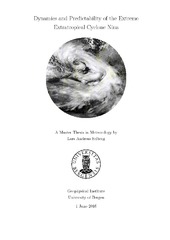| dc.description.abstract | An extreme extratropical cyclone struck western Norway at 12 UTC 10 January 2015 causing significant damage to property due to extreme winds. The European region has a history of being struck by extreme cyclones that cause significant damage to property. Thus, it is important to investigate how these cyclones evolve and to find the cause of their strength. In this study a synoptic analysis of Nina, following a method developed by Boettcher and Wernli (2013), is performed. From the method, it was found that the synoptic environment during Nina featured large low level baroclincity and high moisture content, which are favorable ingredients for formation of a Diabatic Rossby Vortex. It was also found that the presence of an upstream upper level trough, eventually overtaking Nina, caused explosive intensification of the cyclone. Based on the synoptic analysis, strong evidence was found to conclude that Nina evolved similar to a Diabatic Rossby Vortex. In addition, due to significant forecast uncertainty of Nina with respect to the track and location, a sensitivity analysis of the cyclone was performed. From the sensitivity analysis it was found that Nina was heavily influenced by moisture in the low-to mid-levels of the atmosphere, providing additional evidence that Nina evolved similar to a Diabatic Rossby Vortex. By choosing kinetic energy and potential vorticity as response functions in an Adjoint Modeling system at the time of landfall of the cyclone, it was possible to relate the strength and track of Nina to the dynamics at the initial nonlinear field of a forecast. It was found where the initial nonlinear model field could be perturbed to create a stronger storm, and where the initial nonlinear model field could be perturbed to change the track of Nina at landfall. Preceding the synoptic analysis and sensitivity analysis of Nina all relevant theory needed to explain the results is presented. For the sensitivity analysis an accuracy test was performed, to show that the results from the adjoint modeling system are realistic and consistent with the output from the nonlinear model. | en_US |
